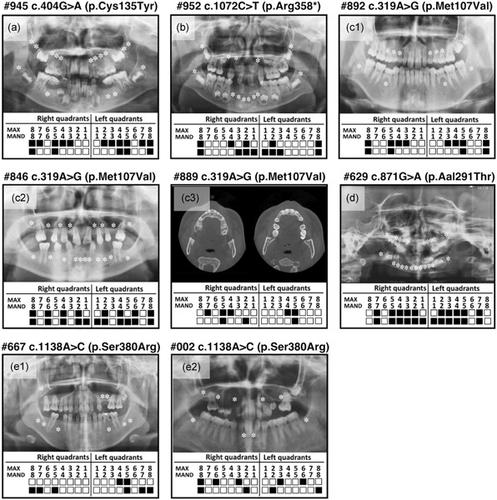当前位置:
X-MOL 学术
›
Hum. Mutat.
›
论文详情
Our official English website, www.x-mol.net, welcomes your
feedback! (Note: you will need to create a separate account there.)
Comparative analysis of rare EDAR mutations and tooth agenesis pattern in EDAR- and EDA-associated nonsyndromic oligodontia.
Human Mutation ( IF 3.3 ) Pub Date : 2020-09-09 , DOI: 10.1002/humu.24104 Liutao Zhang 1 , Miao Yu 1 , Sing-Wai Wong 2 , Hong Qu 3 , Tao Cai 4 , Yang Liu 1 , Haochen Liu 1 , Zhuangzhuang Fan 1 , Jinglei Zheng 1 , Yongsheng Zhou 1 , Hailan Feng 1 , Dong Han 1
Human Mutation ( IF 3.3 ) Pub Date : 2020-09-09 , DOI: 10.1002/humu.24104 Liutao Zhang 1 , Miao Yu 1 , Sing-Wai Wong 2 , Hong Qu 3 , Tao Cai 4 , Yang Liu 1 , Haochen Liu 1 , Zhuangzhuang Fan 1 , Jinglei Zheng 1 , Yongsheng Zhou 1 , Hailan Feng 1 , Dong Han 1
Affiliation

|
Nonsyndromic oligodontia is a rare congenital anomaly. Mutations in the ectodysplasin A receptor (EDAR) gene are the primary cause of hypohidrotic ectodermal dysplasia but are rarely reported in nonsyndromic oligodontia. This study investigated EDAR mutations in multiplex nonsyndromic oligodontia and comparatively analyzed the EDAR‐ and EDA‐related tooth agenesis patterns. Mutation screening was carried out using whole‐exome sequencing and familial segregation. Evolutionary conservation and conformational analyses were used to evaluate the potential pathogenic influence of EDAR mutants. EDAR mutations were found to occur in 10.7% of nonsyndromic oligodontia cases. We reported seven heterozygous mutations of EDAR, including five novel mutations (c.404G>A, c.871G>A, c.43G>A, c.1072C>T, and c.1109T>C) and two known mutations (c.319A>G and c.1138A>C). Genotype–phenotype correlation analysis demonstrated that the EDAR‐related tooth agenesis pattern was markedly different from EDA. The mandibular second premolars were most frequently missing (57.69%) in EDAR‐mutated patients. Our results provide new evidence for the genotypic study of nonsyndromic oligodontia and suggest that EDAR haploinsufficiency results in nonsyndromic tooth agenesis. Furthermore, the distinct pattern between EDAR‐ and EDA‐related tooth agenesis can be used as a guide for mutation screening during the clinical genetic diagnosis of this genetic disorder.
中文翻译:

EDAR 和 EDA 相关非综合征性少牙症中罕见 EDAR 突变和牙齿发育不全模式的比较分析。
非综合征性少牙症是一种罕见的先天性畸形。ectodysplasin A 受体( EDAR ) 基因的突变是少汗性外胚层发育不良的主要原因,但在非综合征性少牙症中很少报道。本研究调查了多发性非综合征性少牙症中的EDAR突变,并比较分析了EDAR和EDA相关的牙齿发育不全模式。使用全外显子组测序和家族分离进行突变筛选。进化保守性和构象分析用于评估EDAR突变体的潜在致病影响。爱达发现突变发生在 10.7% 的非综合征性少牙症病例中。我们报告了EDAR 的7 个杂合突变,包括 5 个新突变(c.404G>A、c.871G>A、c.43G>A、c.1072C>T 和 c.1109T>C)和两个已知突变(c .319A>G 和 c.1138A>C)。基因型-表型相关分析表明EDAR相关的牙齿发育不全模式与EDA显着不同。在EDAR突变患者中,下颌第二前磨牙最常缺失(57.69%)。我们的结果为非综合征性少牙症的基因型研究提供了新的证据,并表明 EDAR 单倍体不足导致非综合征性牙齿发育不全。此外,EDAR - 和EDA相关牙齿发育不全可作为该遗传病临床遗传诊断过程中突变筛查的指导。
更新日期:2020-10-30
中文翻译:

EDAR 和 EDA 相关非综合征性少牙症中罕见 EDAR 突变和牙齿发育不全模式的比较分析。
非综合征性少牙症是一种罕见的先天性畸形。ectodysplasin A 受体( EDAR ) 基因的突变是少汗性外胚层发育不良的主要原因,但在非综合征性少牙症中很少报道。本研究调查了多发性非综合征性少牙症中的EDAR突变,并比较分析了EDAR和EDA相关的牙齿发育不全模式。使用全外显子组测序和家族分离进行突变筛选。进化保守性和构象分析用于评估EDAR突变体的潜在致病影响。爱达发现突变发生在 10.7% 的非综合征性少牙症病例中。我们报告了EDAR 的7 个杂合突变,包括 5 个新突变(c.404G>A、c.871G>A、c.43G>A、c.1072C>T 和 c.1109T>C)和两个已知突变(c .319A>G 和 c.1138A>C)。基因型-表型相关分析表明EDAR相关的牙齿发育不全模式与EDA显着不同。在EDAR突变患者中,下颌第二前磨牙最常缺失(57.69%)。我们的结果为非综合征性少牙症的基因型研究提供了新的证据,并表明 EDAR 单倍体不足导致非综合征性牙齿发育不全。此外,EDAR - 和EDA相关牙齿发育不全可作为该遗传病临床遗传诊断过程中突变筛查的指导。











































 京公网安备 11010802027423号
京公网安备 11010802027423号